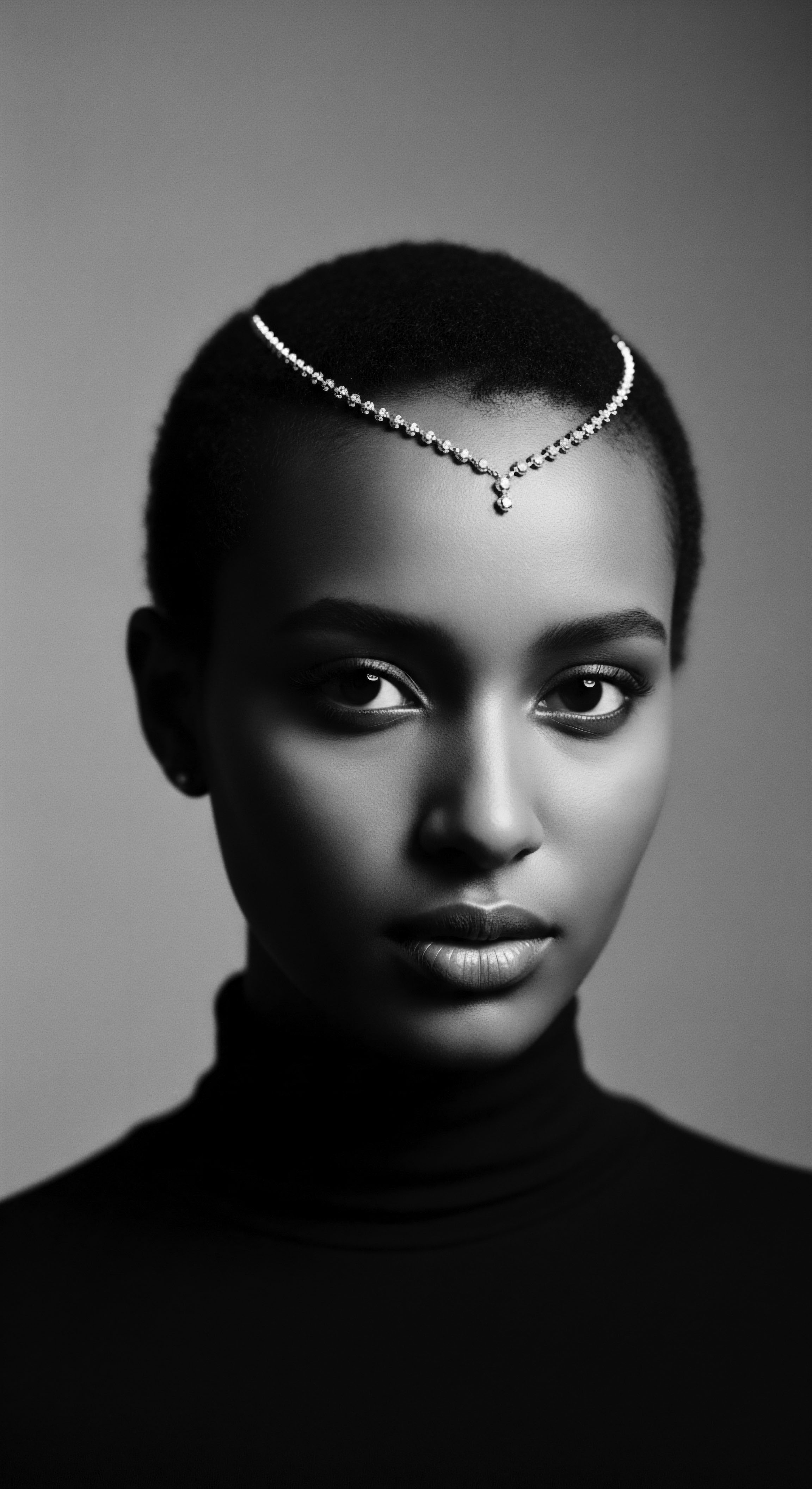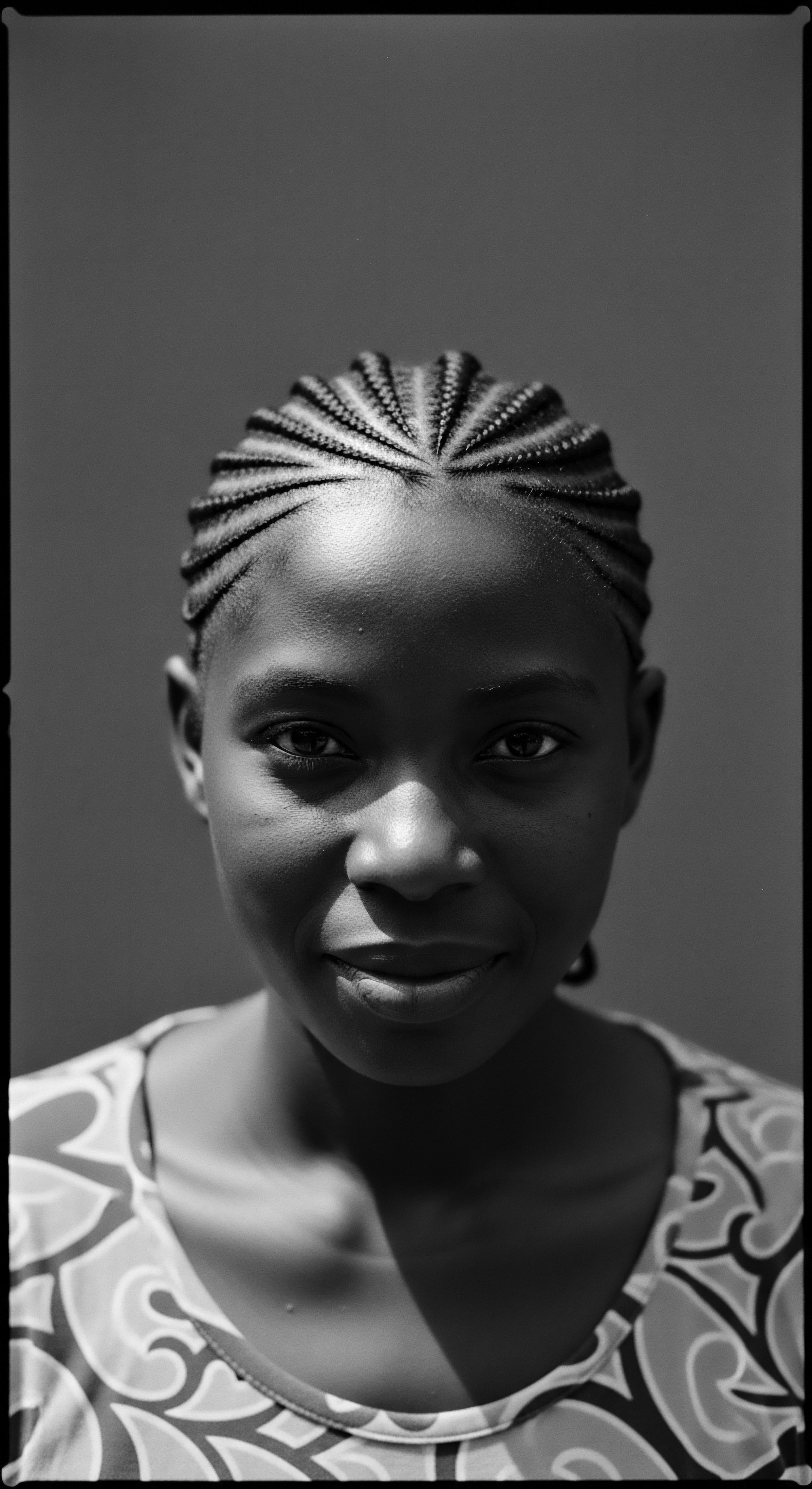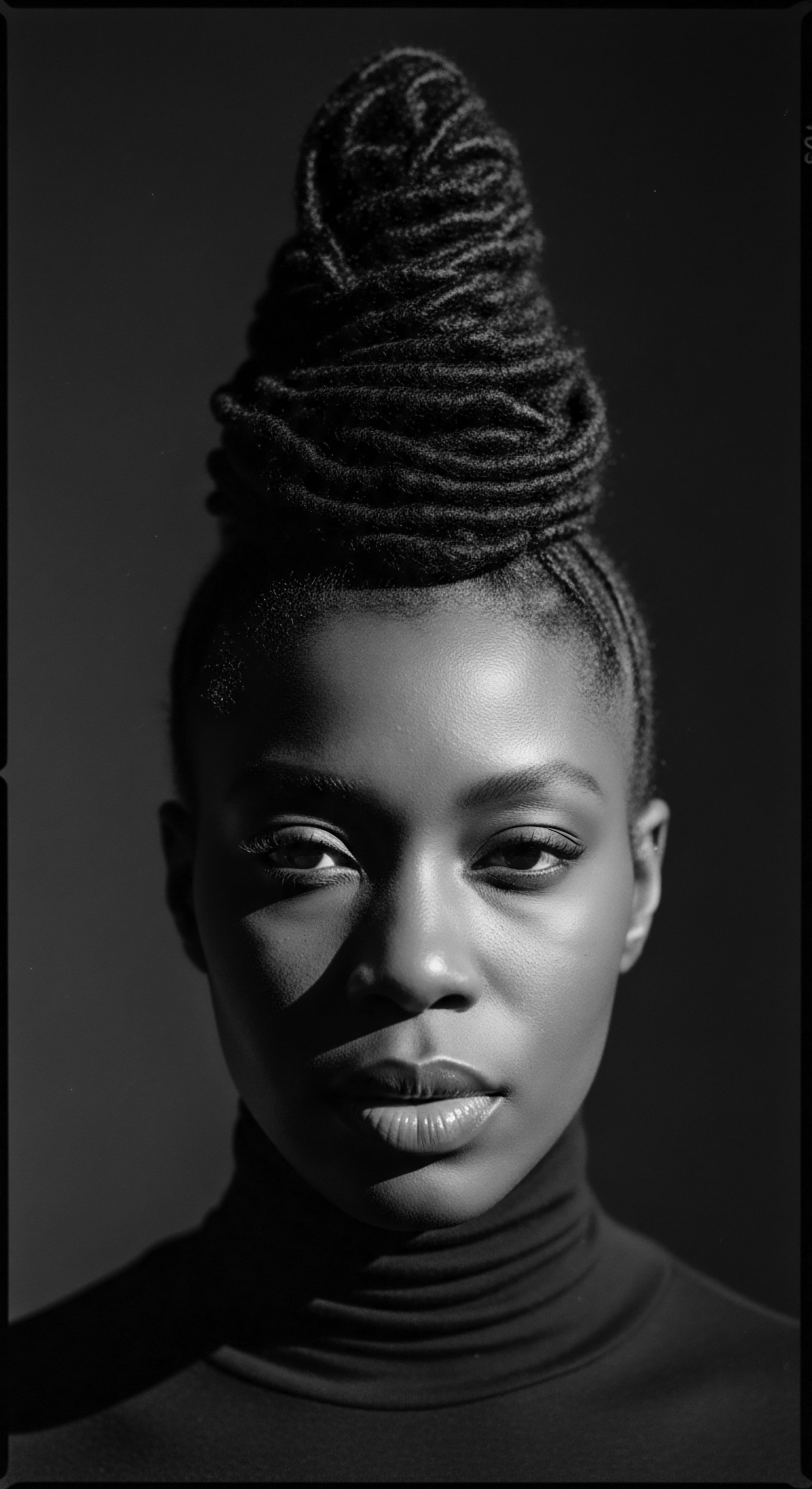
Fundamentals
The concept of Arid Region Botanicals speaks to the extraordinary resilience and profound wisdom held within the plant kingdom, particularly those species that have found a way to not only survive but to flourish in the most challenging of dry, sun-drenched landscapes. At its core, this designation encompasses plants indigenous to deserts, semi-deserts, and other water-scarce environments, each having evolved unique mechanisms to conserve moisture, withstand extreme temperatures, and extract vital nutrients from parched earth. Their very existence is a testament to adaptation, a silent declaration of life’s enduring will against the odds.
For Roothea, this designation carries a significance far beyond mere botanical classification. It represents a living archive of nature’s ingenuity, a source of profound inspiration for the care of Textured Hair. Just as these botanicals hold onto precious water in arid climes, so too does textured hair, with its unique structural patterns, often seek and retain moisture with careful tending. The very elements that grant these plants their tenacity – their ability to store water, create protective barriers, and resist harsh environmental stressors – mirror the inherent needs and strengths of curls, coils, and waves.
Consider the initial meaning of these botanicals ❉ they are nature’s own reservoirs, equipped with an innate understanding of preservation. Their sap, oils, and mucilage often possess remarkable humectant and emollient properties, which are precisely what hair with a more open cuticle structure or a tendency towards dryness craves. This intrinsic connection to moisture, born of survival in scarcity, positions Arid Region Botanicals as fundamental allies in the ancestral pursuit of vibrant, well-nourished hair.
Arid Region Botanicals embody nature’s profound wisdom, offering potent solutions for textured hair care, echoing ancestral practices of moisture retention and protection.
Among the most recognized of these botanical allies are those whose legacies are deeply intertwined with the hair traditions of communities inhabiting dry regions across the globe. Their inclusion in our understanding of hair care is not a modern discovery, but rather a rediscovery, a re-centering of knowledge passed down through generations.

Ancient Wisdom in Every Leaf
From the sun-baked plains of the Sahel to the windswept deserts of North Africa, communities have long turned to their local flora for sustenance and healing. These plants, often dismissed by external gazes as barren landscape inhabitants, were, in fact, the original pharmacies and beauty apothecaries. The application of their extracts, oils, and butters to hair was not merely cosmetic; it was a ritual of protection, a practice of reverence for the self and for the gifts of the earth. The careful selection and preparation of these botanicals speak to an intimate knowledge of their properties, a wisdom cultivated through centuries of observation and communal sharing.
- Aloe Vera (Aloe Barbadensis Miller) ❉ A succulent whose clear, gelatinous pulp has been a staple in traditional healing and hair care across arid regions for millennia. Its natural polysaccharides offer humectant properties, drawing moisture from the air to hair strands, a crucial benefit for parched curls.
- Jojoba (Simmondsia Chinensis) ❉ Native to the Sonoran Desert, its liquid wax, remarkably similar to the natural sebum produced by the human scalp, provides lightweight conditioning and protection without greasiness, historically used by indigenous peoples for hair health.
- Shea Butter (Vitellaria Paradoxa) ❉ Derived from the nuts of the Shea tree, prevalent in the Sahelian belt of West Africa, this rich, emollient butter has been a cornerstone of hair and skin care, revered for its ability to seal in moisture and provide a protective barrier against environmental harshness.
The delineation of Arid Region Botanicals within Roothea’s living library is an acknowledgment of this deep heritage. It is a call to remember the ingenuity of our ancestors, who, with limited resources, perfected the art of nurturing hair using what the earth generously provided. Their understanding of these plants, gained through intimate connection with their environment, offers a powerful lens through which to view modern hair care practices, grounding them in a legacy of holistic wellness and profound respect for natural solutions. This initial explanation sets the stage for a deeper appreciation of their significance, moving beyond simple identification to a recognition of their enduring role in the story of textured hair.

Intermediate
Building upon the foundational understanding of Arid Region Botanicals, our intermediate exploration delves into the intricate mechanisms that allow these plants to thrive in adversity and, by extension, how their unique compositions translate into profound benefits for Textured Hair Heritage. The very survival strategies of these botanical wonders—their ability to sequester water, to create resilient protective layers, and to concentrate vital compounds—become the wellspring of their efficacy in ancestral and contemporary hair care. This section aims to clarify the sophisticated interplay between their biological adaptations and their utility in maintaining the health and vibrancy of curls, coils, and waves, particularly those of Black and mixed-race lineages.
The designation of “Arid Region Botanicals” carries a deeper sense, signifying not just a category of plants, but a testament to life’s persistent creativity. These plants have mastered the art of resilience, often through the development of specialized tissues for water storage, such as the succulent leaves of Aloe, or the production of waxes and oils that minimize transpiration, like those found in Jojoba. Their existence is a profound statement on adaptability, a blueprint for thriving in conditions that would challenge most other life forms.

Botanical Adaptations, Hair Solutions
The connection between the resilience of Arid Region Botanicals and the care of textured hair is more than poetic; it is rooted in shared needs. Textured hair, by its very nature, often possesses a more porous cuticle and a propensity for dryness, making it susceptible to moisture loss in varying climates. The solutions engineered by arid plants offer direct parallels:
- Water Retention ❉ Many arid botanicals, like the Baobab tree (Adansonia digitata) native to parts of Africa, store immense quantities of water within their trunks or fruits. Similarly, their extracts, rich in mucilage or polysaccharides, help textured hair attract and hold onto moisture, mitigating dryness that can lead to breakage.
- Protective Barriers ❉ Plants like the Argan tree (Argania spinosa) produce oils that coat their leaves, reducing water evaporation. When applied to hair, these oils form a natural, breathable film that shields strands from environmental aggressors, such as sun and wind, while sealing in hydration. This protective quality is vital for maintaining the integrity of delicate hair strands.
- Nutrient Concentration ❉ Surviving in nutrient-poor soils forces arid plants to be incredibly efficient at concentrating vital minerals and vitamins. These concentrated nutrients, when extracted, provide a potent dose of nourishment to the scalp and hair follicles, supporting healthy growth and reducing fragility.
This elucidation reveals how the inherent meaning of these botanicals, born from their struggle for survival, directly translates into their practical benefits for hair. The traditional practices that recognized and harnessed these properties were not random acts; they were sophisticated applications of inherited wisdom, a deep understanding of natural chemistry before the advent of formal science.
The resilience of Arid Region Botanicals, born from their survival strategies, offers a powerful parallel to the needs of textured hair, providing solutions for moisture retention and protection.

Echoes of Ancestral Care Rituals
The integration of Arid Region Botanicals into hair care traditions across the African continent and its diaspora is a testament to their enduring value. These were not luxury items but daily essentials, woven into the fabric of communal life and personal grooming. The practices surrounding their collection, preparation, and application were often communal, fostering a sense of shared identity and intergenerational connection.
For instance, the use of Shea butter is not merely about applying a product; it is a ritual passed from elder to youth, a demonstration of care that connects individuals to a long lineage of nurturing. Women in West African communities have traditionally engaged in the labor-intensive process of extracting Shea butter, a practice that builds communal bonds and economic independence. This traditional knowledge, often transmitted orally and through demonstration, embodies a profound understanding of the butter’s properties and its application for hair health and protection against the harsh dry season.
(Fage, 1988). The butter’s efficacy in preventing breakage and maintaining softness in textured hair, especially during dry periods, was recognized long before scientific analysis confirmed its rich fatty acid profile and unsaponifiable content.
| Botanical Shea Butter (Vitellaria paradoxa) |
| Traditional Application (Heritage Context) Used by women across the Sahel for daily hair conditioning, scalp massage, and protective styling, often applied in its raw, unrefined state to seal in moisture and protect from sun. |
| Contemporary Benefit for Textured Hair Deep conditioning, frizz reduction, moisture sealant, scalp health, UV protection for curls and coils. |
| Botanical Argan Oil (Argania spinosa) |
| Traditional Application (Heritage Context) Berber women in Morocco traditionally used it for softening hair, adding shine, and treating dryness, often mixed with other natural ingredients for hair masks. |
| Contemporary Benefit for Textured Hair Lightweight conditioning, shine enhancement, elasticity improvement, and heat protection for various textured hair types. |
| Botanical Baobab Oil (Adansonia digitata) |
| Traditional Application (Heritage Context) Extracted from the seeds of the "Tree of Life," used in Southern and East African traditions for hair strength, elasticity, and scalp nourishment, often applied as a restorative treatment. |
| Contemporary Benefit for Textured Hair Supports hair strength, reduces breakage, promotes elasticity, and provides a rich source of vitamins for scalp vitality. |
| Botanical These botanicals, revered for generations, continue to bridge ancient wisdom with modern hair care needs, honoring a continuous lineage of natural solutions. |
The significance of these practices extends beyond physical well-being. Hair, in many African and diasporic cultures, is a powerful symbol of identity, status, spirituality, and resistance. The meticulous care provided by these botanicals speaks to a deep respect for the self and one’s lineage.
Understanding Arid Region Botanicals at this intermediate level means appreciating their journey from elemental biology to cherished cultural artifacts, recognizing their place not just in nature, but in the living, breathing heritage of textured hair care. This perspective invites a more profound engagement with our hair’s story, recognizing the ancient wisdom embedded in every strand.

Academic
The academic delineation of Arid Region Botanicals transcends a mere classification of drought-tolerant flora; it represents a rigorous inquiry into the phytochemistry, ethnobotanical history, and socio-economic impact of plant species adapted to xeric environments, particularly as they relate to the unique physiological and cultural requirements of Textured Hair. This perspective demands a multidisciplinary lens, drawing insights from botany, organic chemistry, anthropology, and dermatology to fully grasp the profound significance and enduring legacy of these natural resources within the context of Black and mixed-race hair experiences. The core meaning of these botanicals, from an academic standpoint, lies in their complex biochemical profiles and their historical role as central pillars of ancestral hair care practices, often validated by contemporary scientific methodologies.
The designation of Arid Region Botanicals, at this expert level, necessitates a deep comprehension of their evolutionary adaptations. These plants exhibit remarkable strategies, including crassulacean acid metabolism (CAM) for efficient water use, extensive root systems to access deep water tables, and specialized epidermal structures (e.g. thick cuticles, trichomes) to minimize transpirational water loss.
These biological marvels yield compounds — such as specific fatty acids, polysaccharides, sterols, and triterpenes — that possess intrinsic properties highly beneficial for hair, particularly those types prone to dryness and breakage due to their structural characteristics. The explication of these botanical adaptations offers a robust scientific underpinning for their historical efficacy.

Phytochemical Sophistication and Hair Morphology
The interaction between the biochemical constituents of Arid Region Botanicals and the unique morphology of textured hair is a subject of considerable academic interest. Coiled and curly hair types, characterized by elliptical cross-sections and frequent twists along the hair shaft, present distinct challenges regarding moisture distribution and structural integrity. Sebum, the scalp’s natural oil, often struggles to travel down the helical path of these strands, leading to dryness at the ends. This makes external lipid application and humectant provision paramount.
From a scientific standpoint, the beneficial properties of Arid Region Botanicals are not anecdotal but are increasingly substantiated by research. For instance, the high concentration of mucilage in plants like Aloe Vera (Aloe barbadensis miller) provides a natural humectant effect, capable of attracting and retaining atmospheric moisture on the hair shaft. Its polysaccharides, such as acemannan, contribute to a soothing effect on the scalp, addressing common concerns like irritation and dryness. (Choi & Chung, 2014).
Similarly, the wax esters of Jojoba Oil (Simmondsia chinensis) closely mimic human sebum, allowing for effective conditioning without disrupting the scalp’s natural lipid balance, a crucial aspect for maintaining a healthy follicular environment. This natural affinity renders Jojoba an ideal emollient for textured hair, providing lubrication and reducing friction, which can minimize mechanical damage.
The academic interpretation of Arid Region Botanicals reveals their complex biochemical profiles and their profound historical role in ancestral hair care, validated by modern scientific inquiry.

Case Study ❉ The Enduring Legacy of Shea Butter (Vitellaria Paradoxa)
Among the Arid Region Botanicals, Shea butter stands as a preeminent example of deep ethnobotanical and socio-economic significance, particularly within the context of Black Hair Experiences and ancestral practices. Native to the Sahelian belt of West Africa, the Shea tree (Vitellaria paradoxa) has been a cornerstone of traditional economies and cultural practices for millennia. Its nuts yield a rich, unctuous butter, the preparation of which is a highly skilled, labor-intensive process traditionally undertaken by women, forming a vital source of income and community cohesion. (Lovett, 2008).
The scientific understanding of Shea butter’s efficacy for textured hair lies in its unique lipid profile. It is rich in stearic and oleic fatty acids, which provide significant emollient and occlusive properties, effectively sealing moisture into the hair shaft. However, its true distinction arises from its high concentration of unsaponifiable matter (typically 5-17%), which includes phytosterols, triterpenes (like cinnamic acid esters), and vitamins A and E. These unsaponifiables are largely responsible for Shea butter’s reputed anti-inflammatory, antioxidant, and UV-protective qualities, making it more than a simple moisturizer.
(Akihisa et al. 2010). For textured hair, this translates into superior protection against environmental stressors, reduced protein loss, and enhanced elasticity, directly addressing common concerns such as dryness, breakage, and dullness.
The historical application of Shea butter extends beyond daily grooming. In many West African cultures, Shea butter played a role in ceremonial rites, postpartum care, and the protection of infants’ skin and hair. Its presence in oral histories and traditional medicinal texts underscores its pervasive importance.
The butter’s ability to soften and protect hair made it indispensable for intricate traditional hairstyles, which often served as markers of age, marital status, or tribal affiliation. This practical utility, combined with its cultural reverence, provides a compelling illustration of the deep connection between botanical resources, ancestral practices, and the construction of identity.

Interconnected Incidences ❉ Global Markets and Traditional Knowledge
The increasing global demand for Shea butter presents a complex intersection of academic inquiry, economic development, and cultural preservation. While commercialization offers economic opportunities for women’s cooperatives in producing regions, it also raises critical questions regarding sustainable harvesting, equitable trade practices, and the potential erosion of traditional knowledge. Research by scholars in development studies and ethnobotany frequently examines how the global market impacts local ecological practices and social structures, emphasizing the need for ethical sourcing that respects ancestral land rights and traditional processing methods. This academic lens allows for a nuanced understanding of the long-term consequences of commodifying such a culturally significant botanical.
The very success of Shea butter in the global cosmetic industry highlights a recurring theme ❉ modern science often validates the wisdom held within ancestral practices. The rigorous analysis of its chemical composition and therapeutic effects provides a scientific language for phenomena understood intuitively for centuries. This intellectual convergence encourages a respectful dialogue between traditional ecological knowledge and contemporary scientific investigation, emphasizing the continuous thread of human ingenuity in adapting to and utilizing natural environments. The delineation of Arid Region Botanicals, therefore, is not merely about listing plants; it is about acknowledging a rich, complex history of human interaction with nature, a history profoundly intertwined with the narrative of textured hair and its enduring heritage.
From an academic perspective, the long-term success of incorporating Arid Region Botanicals into modern hair care formulations rests on a commitment to understanding their full ecological and cultural context. This involves supporting research into lesser-known arid botanicals, advocating for fair trade practices that benefit indigenous communities, and recognizing the intellectual property inherent in traditional knowledge systems. The academic exploration of Arid Region Botanicals provides a framework for responsible innovation, ensuring that the benefits derived from these plants honor their deep historical roots and contribute to the well-being of the communities who have stewarded them for generations. This profound understanding allows us to appreciate the true essence of these botanicals as vital elements in the living library of hair care, a testament to ancestral wisdom and enduring natural efficacy.

Reflection on the Heritage of Arid Region Botanicals
As we conclude our exploration of Arid Region Botanicals, a profound meditation on their enduring legacy settles upon us, echoing the very ‘Soul of a Strand’ ethos that guides Roothea’s living library. These resilient plant allies are more than mere ingredients; they are venerable storytellers, their very existence a testament to the tenacity of life and the ingenuity of ancestral hands. Their journey, from elemental biology in harsh landscapes to cherished components of textured hair care, reflects a continuous, unbroken lineage of wisdom passed through generations.
The significance of Arid Region Botanicals within the narrative of textured hair is not simply about their biochemical efficacy, though that is undeniable. It resides deeply in their cultural resonance, their role in rituals of self-care that connected individuals to community, to ancestry, and to the earth itself. Every application of Shea butter, every infusion of Aloe, carried with it the silent blessings of grandmothers, the echoes of communal gatherings, and the strength of a heritage that found beauty and sustenance in scarcity. This connection to ancestral practices provides a powerful anchor in a world often seeking quick, fleeting solutions.
For Roothea, these botanicals represent a profound recognition ❉ that the answers to our hair’s needs often lie not in the newest synthetic compound, but in the oldest, most time-tested wisdom. They remind us that true care is holistic, extending beyond the physical to touch the spiritual and the communal. They beckon us to remember the resilience of our hair, mirroring the resilience of the arid lands from which these botanicals spring, and the resilience of the people who nurtured them into their lives.
The future of textured hair care, therefore, is not solely about scientific advancement; it is equally about honoring the past, listening to the quiet counsel of the earth, and preserving the sacred traditions that have sustained our strands through centuries. This reflection on Arid Region Botanicals is an invitation to walk a path of reverence, recognizing that every strand holds a story, and every botanical a piece of an ancient, life-giving song.

References
- Akihisa, T. Kojima, N. Kikuchi, T. Yasukawa, K. Tokuda, H. T. T. (2010). Anti-inflammatory and Chemopreventive Effects of Triterpene Cinnamates and Acetates from Shea Butter. Journal of Oleo Science, 59(4), 183-190.
- Choi, S. & Chung, M. H. (2014). A review on the relationship between Aloe vera and its beneficial effects on skin. Phytotherapy Research, 28(10), 1431-1439.
- Fage, J. D. (1988). A History of Africa. Routledge.
- Lovett, J. C. (2008). The Shea Tree (Vitellaria paradoxa Gaertn. f.) ❉ A Handbook for Practitioners. Bioversity International.
- Wickens, G. E. (1995). Edible Nuts. Food and Agriculture Organization of the United Nations.
- Djerbi, M. (2009). The Argan Tree (Argania spinosa) ❉ A Monograph. Centre de Coopération Internationale en Recherche Agronomique pour le Développement (CIRAD).
- Kuhnlein, H. V. & Turner, N. J. (2006). Traditional Plant Foods of Canadian Indigenous Peoples ❉ Nutrition, Botany, and Culture. CRC Press.
